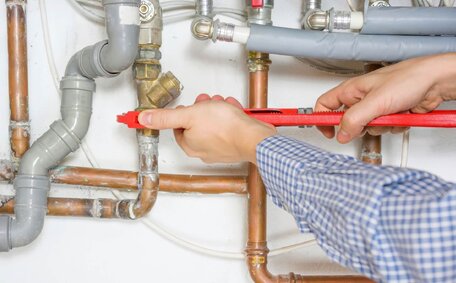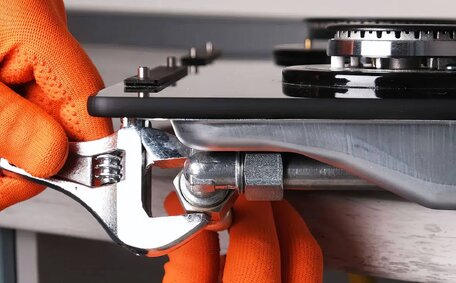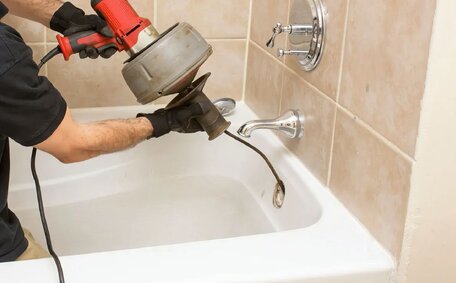
Sustainable Gas Solutions
There are renewable and sustainable gas solutions that can build a greener future. Gas has a key role enabling the transition to renewable energy while reducing emissions.
Read MoreTMV tempering systems, also known as thermostatic mixing valves, are specialised plumbing fixtures installed into hot water delivery systems. Its main function is to blend cold water with flow hot to ensure hot water tempering that delivers a constant, safe temperature water supply.
Mixing valves regulate water temperature by using a thermostatic element that senses water temperature changes and adjusts the ratio of hot cold water flow.
There are two main types of mixing valves: manual tempering valves and thermostatic mixing valves (TMVs). Manual valves require manual adjustment to set the temperature, while TMVs, more advanced than tempering valves, automatically self-adjust to maintain a constant output temperature.
Mixing valve TMVs, particularly TMVs, serve several important purposes in both residential and commercial plumbing heating systems:
There are two main types of mixing valves used in plumbing systems:
Manual tempering valves are becoming more common, unlike valves TMVs which self-regulate, allow manual adjustment of water temperature via a handle, and the mixing valve can be set to a preferred temperature. They can be set to a fixed temperature, and, unlike TMVs, do not self-adjust but the valve can be adjusted as needed. Manual valves need to be checked and reset periodically as the temperature of your water supplied valve can adjusted, a process that must be carried out with diligence.
Tempering valve thermostatic models, which can be intuitively adjusted, automatically blends hot cold water to maintain a constant, pre-set output temperature. They contain a thermostatic element that detects changes water temperature and can adjusted, fine-tuning the ratio of hot and cold water flow accordingly. This compensates for fluctuations in hot water system temperatures, as the valve can be adjusted accordingly.
TMVs are more precise in sustaining set temperature outputs and safer as they instantly react to sudden changes in hot water temperature. Most plumbing regulations now mandate installing TMV for applications like showers and baths to guide cold water into a blending mechanism, minimising risks from scalding hot water.
The difference between manual tempering valves and TMVs is that the former allows users to manually adjust water temperature by changing the mix of cold hot water flow. They contain a mixing chamber that manages water tempering by mixing hot cold water together from the respective supply lines at an adjustable ratio.
To operate a manual mixing valve:
Key applications for manual mixing valvea include:
Benefits of manual valves in your hot water system:
Considerations when using manual valves:
Thermostatic mixing valves (TMVs) automatically blends hot with cold, thereby maintaining a constant, pre-set output temperature usually between 43°C-50°C. Tempering valves TMVs employ a mechanism that accurately gauges the temperature hot water fluctuations and instantly adjusts the ratio of hot to cold water flow to compensate.
This advanced management ensures the thermostatic mixing valve can maintain cold-intake in sync and deliver water temperatures precise within 1°C of their set point. TMVs can provide consistent temperature mixed water temperatures and also offer scalding protection by instantly reacting to sudden spikes in temperatures that are too hot.
Common applications where valve tempering mechanisms like TMVs are mandated by plumbing regulations include:
unlike in the manual valve vs tempering technology comparison, TMVs eliminate the need for regular manual temperature testing and adjustment by providing control water temperature. The ability to maintain constant precision temperature control when you install tempering valve makes it the preferred and safer choice for most hot water applications.
When comes to installing a TMV, licenced plumbers can ensure it becomes an integrated part of the hot water delivery system, usually close to the point of use, such as showers or sinks. Some key installation guidelines include:
Typical installation locations where valves TMVs can be installed, with a focus on mitigating risk of scalding, are in residential settings:
In commercial sites they may be placed:
All mixing valve installations require a TMV licence and must have work done in compliance with the plumbing code, ensuring safe delivery of hot water at the correct temperatures and minimizing the risk of scalding.
Installing a mixing valve tempering system, particularly the thermostatic mixing variant, provides several notable benefits, including:
By regulating hot water to safe temperature levels, ensuring they’re no higher than 50°C, mixing valves greatly reduce the risk of tap water scalding, which is especially important for vulnerable groups like children.
Valve TMV technology can ensure your hot water systems in environments like hospitals aged care are set to higher temperatures to prevent bacterial growth, while delivering output temperatures safe for use. This reduces reheating and improves energy efficiency.
Mixing valves deliver a constant, pre-set temperature regardless of fluctuations in the hot water system’s temperature. This provides consistent performance.
With TMVs installed and tempering valves ensures the temperature of mixed water is in compliance with plumbing regulations around safe hot water delivery temperatures in settings like aged care homes, hospitals, and schools.
Temperatures can be safely set higher than 50°C within hot water systems to reduce the proliferation of Legionella bacteria, relying on mixing valves to lower output temperatures.
The decision between installing a tempering valve or a thermostatic mixing valve is crucial for preventing tap water scalds and burns. Studies show hot water temperatures above 50°C can cause third-degree burns in just 1 second. Temperatures above 45°C are also considered unsafe.
By regulating temperatures to a safe level, mixing valves greatly reduce scald risks from cold hot water use in settings like:
TMVs are more reliable for delivering a safe preset temperature consistently. Installing tempering valves, including TMVs in child care facilities and all hot water outlets is crucial, especially those accessible to vulnerable groups.
This ensures compliance with plumbing regulations aimed at minimising the huge physical, emotional and financial burden of hot water scalding incidents in homes and public spaces.
Mixing valves can help improve energy efficiency in several ways:
With a mixing valve regulating output temperatures, hot water systems can be safely set to higher temperatures ensuring the water comes out at the right temperature up to 70°C. This approach refines water output temperature control and reduces the energy needed to reheat water repeatedly.
When it comes to achieving balance, mixing valves reduce the need to run taps or showers longer by instantly balancing hot water cold streams at optimum temperatures. This conserves water usage.
In solar water heating systems, very hot water from solar collectors passes through a tempering valve which transforms it to moderate water hot enough yet safe levels for end use. This allows renewable energy to offset heating requirements.
Overall, incorporating mixing valves enables hot water systems to run more efficiently. This translates into lower energy bills and reduced consumption for both residential and commercial sites.
Installing mixing valves can prolong the lifespan of water heating systems. Without mixing valves, heaters endure repeated extreme temperature fluctuations as water is heated from cold to hot then drawn out for use. Such temperature cycling strains components and causes expansion/contraction stresses over time.
Mixing valves allow heaters to maintain a consistently hotter temperature setting of 70°C or more. The high temp reduces energy wasted reheating cooler water. But the valve’s tempering effect blends this hot supply down to 50°C or less before delivery. Such stable temperature control reduces wear and tear - extending the operational life of heaters by years.
This prevents scalding.
So while mixing valves primarily deliver safety and efficiency benefits, their ability to moderate internal heater temperatures also safeguards system longevity. Installing quality tempering valves or TMVs is crucial for maximising ROI across hot water infrastructure.
In the tug of war between tempering cold water and hot, installing new mixing valves or replacing old ones should be considered in the following situations:
All new hot water installations require mixing valves to comply with plumbing codes and prevent scalding risks. Having a TMV valve installed is preferred due to its precision temperature control.
If an existing mixing valve fails to properly regulate water temperature, exhibits leaks, or no longer reacts quickly to temperature changes, replacement is needed.
Understanding the differences between a manual valve and an automatic TMV reveals that the latter provides enhanced accuracy, safety and reliability in maintaining the set temperature.
In settings like childcare facilities, hospitals and nursing homes, by installing a TMV, you can ensure precise scalding prevention for vulnerable occupants.
Mixing valves have an average lifespan around 10 years. Valves should be reassessed and possibly replaced with an install of tempering mechanisms every 5 years, as old ones are more prone to scaling, sticking, and failure to regulate temperatures accurately.
Replacing ageing valves restores peak performance and temperature control precision while remedying age-related faults.
You need know if your current setup necessitates a new valve? Our licenced Inner West plumbers can install all required controls, regulating water temperature to suit your setup and advise if installing or replacing a mixing valve is warranted to improve safety, efficiency, and reliability.
Selecting the most suitable mixing valve depends on factors like the application, water heater type, and whether it’s for residential or commercial use.
When it comes to manual tempering valves, they offer a cost-effective option for basic temperature regulation in low-risk scenarios like hand basins. But when thinking about thermostatic mixing for high-risk applications like showers, TMVs (TMVs) are strongly recommended and often mandated.
The valve, thermostatic in its operation, can adjust temperature with meticulous precision, providing the most exact temperature control (1°C), instant scalding protection and automatic self-regulation. Their hands-free set-and-forget functionality ensures ongoing safety and energy savings. TMVs are compatible with all water heater types and suitable for whole-of-home installation. TMVs are compatible with all water heater types and suitable for whole-of-home installation. We tailor mixing valve selection and professional installation to your needs while ensuring full compliance with your plumbing regulations.
For more insights and expert advice, visit our contact page or call Inner West Plumbing on 1300 349 338 for personalised mixing valve solutions backed by over 10 years of local experience.
There are renewable and sustainable gas solutions that can build a greener future. Gas has a key role enabling the transition to renewable energy while reducing emissions.
Read MoreGas leaks can cause headaches, nausea, breathing issues and even carbon monoxide poisoning. Long term exposure poses serious health risks. Call us to fix any gas leak and avoid the dangers - Inner West Plumbing
Read MoreTree roots are the #1 cause of blocked drains as they invade pipes seeking water. Call Inner West Plumbing on XXXX XXX XXX to inspect & clear roots.
Read MoreInner West, NSW
We will call back as soon as possible.




